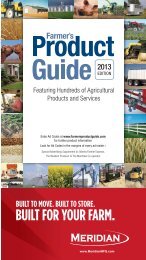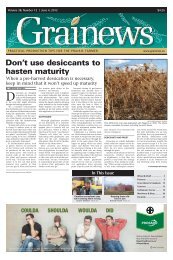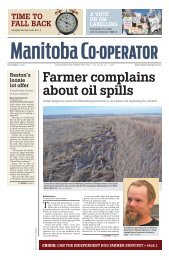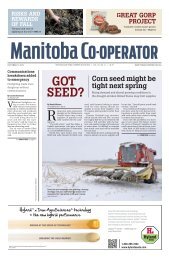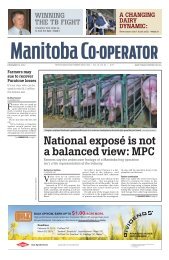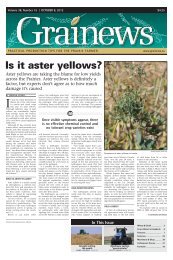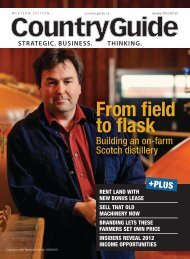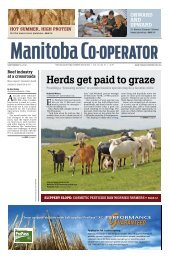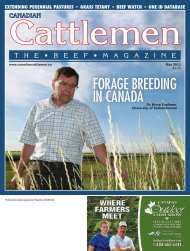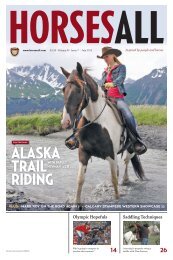Create successful ePaper yourself
Turn your PDF publications into a flip-book with our unique Google optimized e-Paper software.
4 The Manitoba Co-operator | July 12, 2012<br />
OPINION/EDITORIAL<br />
Accountability,<br />
public health and trade<br />
Reading between the lines of the article<br />
by Canada’s top veterinarian in<br />
the July issue of the Canadian Veterinary<br />
Journal, this country suffers from<br />
a jurisdictional void that constrains its<br />
ability to address a high-priority public<br />
health issue.<br />
The World Health Organization and the<br />
World Organization for Animal Health<br />
have both been sounding the alarm over<br />
Laura Rance<br />
the growing problem of pathogens that<br />
Editor<br />
are becoming resistant to the antimicrobials<br />
used in both human and animal<br />
health. The WHO went so far last year as to warn that the<br />
world is on the brink of losing these “miracle cures” a mere<br />
60 years after their introduction.<br />
There is little argument that the are being abused. In<br />
human health, doctors routinely describe antibiotics as<br />
a precaution and patients often stop taking their pills as<br />
soon as they start to feel better. In livestock production,<br />
they are frequently used as growth promoters rather than<br />
to treat sickness.<br />
Dr. Brian Evans, whose job these days is to serve not only<br />
as the country’s chief veterinarian but its chief food-safety<br />
officer, treads carefully in his article, calling the misuse of<br />
antimicrobials in human and animals a “complex, multifactorial<br />
problem.”<br />
The way he describes it, three federal agencies — the<br />
Public Health Agency of Canada, Health Canada and the<br />
Canadian Food Inspection Agency (CFIA) — monitor for<br />
resistant microbes in the food-animal sector. That surveillance<br />
shows that antimicrobial resistance is rising.<br />
The CFIA also watches for drug residues in food and<br />
makes sure livestock feeds meet federal standards. Health<br />
Canada encourages prudent use of antimicrobial drugs<br />
and has gone so far as to categorize these drugs according<br />
to their importance to human medicine. It has a policy<br />
on extra-label use of veterinary drugs and recommends<br />
against using the critically important ones in mass-medication<br />
situations. But the key words here are “encourage,”<br />
“policy” and “recommends.”<br />
Extra-label use and prescribing medication for livestock<br />
is done by veterinarians, who are regulated by provincial<br />
governments. But use of these medications, short of ensuring<br />
they meet efficacy and safety standards, is barely regulated<br />
at all.<br />
So, we know — or at least the federal government knows<br />
— the problem of antimicrobial resistance is getting worse.<br />
But it can’t do anything about it.<br />
And because many of these drugs do not require a prescription<br />
from a vet to obtain, there is no way of monitoring<br />
how much or how often they are used.<br />
“In Canada, we do not know the quantities of various<br />
antimicrobials used in animals, and we do not collect use<br />
data in a manner that helps to further our understanding<br />
of resistance and its impact on human health,” says the<br />
report Uses of Antimicrobials in Food Animals in Canada:<br />
Impact on Resistance and Human Health.<br />
The committee behind this report recommended that be<br />
changed, although it acknowledged that forcing producers<br />
to obtain a prescription would increase costs and would<br />
meet with resistance.<br />
“It is important that this information be available in<br />
the future. These data are needed to interpret changes in<br />
resistance over time, to assess the impact of resistance on<br />
human health, and for development and evaluation of programs<br />
designed to contain antimicrobial resistance,” the<br />
committee said.<br />
Judging from the Evans article, there has been little<br />
progress on this front over the past decade.<br />
The U.S., as well as many other countries, also lacks<br />
data, the report noted. The available estimates for the U.S.<br />
vary widely between 50 per cent and 87 per cent of the<br />
antibiotics sold annually in the U.S. are for growth promotion<br />
and prophylaxis in swine, cattle and poultry.<br />
But the U.S. Food and Drug Administration was recently<br />
raked over the coals by a U.S. magistrate for its reluctance<br />
to stare down the powerful meat-industry lobby on this<br />
issue.<br />
“For over 30 years, the agency has been confronted with<br />
evidence of the human health risks associated with the<br />
widespread subtherapeutic use of antibiotics in foodproducing<br />
animals, and, despite a statutory mandate to<br />
ensure the safety of animal drugs, the agency has done<br />
shockingly little to address these risks,” Judge Theodore<br />
Katz said in a recent ruling, It ordered the FDA to reverse<br />
its decision to ignore consumer petitions calling for more<br />
stringent controls.<br />
If the U.S. moves forward on this front, Canada will be<br />
forced to follow. Simply encouraging prudence and judicious<br />
use won’t be enough to convince trading partners<br />
that our use of antimicrobials is under adequate control.<br />
laura@fbcpublishing.com<br />
U.S. farmers don’t deserve<br />
more subsidy: think-tank<br />
An excerpt from “Field of Schemes,<br />
The Taxpayer and Economic Welfare<br />
Costs of Shallow-Loss Farming<br />
Programs,” a paper published by the<br />
American Enterprise Institute under its<br />
“American Boondoggle: Fixing the 2012<br />
Farm Bill” Series. The AEI says U.S. farm<br />
policy consists of “an array of subsidies,<br />
regulations, spending programs, and<br />
land-use restrictions that are widely<br />
blamed for the increased cost of food,<br />
environmental degradation, fiscal<br />
burdens, and the failure of global trade<br />
negotiations.”<br />
Since 2007, American farmers have consistently<br />
enjoyed record crop prices,<br />
increasing yields, and record farm<br />
incomes. Nevertheless, they still want as many<br />
farm subsidies as they can get, ideally through<br />
programs that lock them into their current<br />
record income levels.<br />
Most — though not all — farm lobbies have<br />
recognized that the Direct Payments Program,<br />
a $5 billion-a- year welfare program in which<br />
payments mainly go to larger and wealthier<br />
farms, is no longer politically viable. Consequently,<br />
over the past two years, many farm<br />
groups have rushed to embrace the concept<br />
of shallow-loss programs.<br />
Shallow-loss programs would provide farm-<br />
OUR HISTORY: July 13, 1961<br />
ers who produce crops like corn, soybeans,<br />
and wheat with subsidies when current-year<br />
revenues for that crop fall below about 90 per<br />
cent of their average levels over the previous<br />
five years. The farm lobby typically claims<br />
that farmers deserve an extensive shallow-loss<br />
income “safety net” because, without it, so<br />
many of them would go broke that the American<br />
food supply chain would fail to deliver<br />
enough food for the rest of the population.<br />
The reality is very different. The current<br />
average debt-to-asset ratio in the farm sector<br />
is less than nine per cent and has been declining<br />
steadily over the past decade. Moreover,<br />
farms fail at a rate of less than one in two hundred<br />
a year, and, from a financial perspective,<br />
farms are better placed than almost any sector<br />
of the economy to handle year-to-year variations<br />
in revenues and costs by themselves. Yet,<br />
effectively, farmers want a taxpayer-funded<br />
guarantee that their revenues will never fall<br />
below about 90 per cent of their recent levels.<br />
Imagine how much homeowners in California,<br />
Nevada, and Florida would have enjoyed<br />
if, in 2008, the government had guaranteed<br />
that no matter when they sold their homes,<br />
homeowners would receive no less than the<br />
price for which they could have sold their<br />
properties at the peak of the housing bubble.<br />
And just think how unreasonable and<br />
outrageously costly for the taxpayer such a<br />
program would be. Yet this is essentially what<br />
farmers are seeking, and what the congressional<br />
agricultural committees are considering<br />
providing.<br />
The Co-operator’s July 13, 1961 issue featured<br />
several stories related to the drought that year,<br />
which turned out to be the driest on record<br />
in Western Canada. Rain the previous week was<br />
thought to be too late to save the “doomed” crop.<br />
The province had set up a plan to pay farmers a<br />
bonus of $5 per ton if they would allow their standing<br />
crops to be cut for forage. The wheat board had<br />
withdrawn from the durum market, and there were<br />
egg shortages resulting from the hot weather.<br />
In the following issue it was reported that Premier<br />
Duff Roblin had announced a plan to help farmers buy<br />
hay from the U.S. at “reasonable prices.”<br />
In our classified section, a half section two miles<br />
west of the Cordova elevator, 240 acres broken with<br />
“fair” buildings, was offered at $45 per acre, “crop and<br />
all.”<br />
Address accuracy, let alone postal codes, was apparently<br />
not a concern in 1961. Another ad read, in full:<br />
“Used welders, write us today, stating requirements.<br />
Smith Roles, Saskatoon.”



